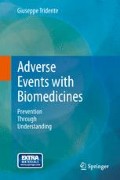Abstract
Adverse Drug Events (ADEs) are commonly differentiated in two classes: Type A, as predictable reactions related to the pharmacological properties of the drug in study; Type B, as unpredictable events in predisposed individuals. The former group includes side effects, toxicity of overdose, secondary effects, and drug interactions. Overall, they contribute for about 80–90 % of ADEs. The latter group includes hypersensitivity (immunological) reactions, and non-specific reactions, such as pseudo-allergic (anaphylactoid) reactions and idiosyncrasy, all contributing for the remaining 10–20 % of events [1, 2].
Access this chapter
Tax calculation will be finalised at checkout
Purchases are for personal use only
References
Rawlins M, Thompson W (1991) Mechanisms of adverse drug reactions. In: Davies D (ed) Textbook of adverse drug reactions. Oxford University Press pg, New York, pp 18–45
Schnyder B, Pichler WJ (2009) Mechanisms of drug-induced allergy. Mayo Clin Proc 84:268–272
Aronson JK, Ferner RE (2003) Joining the DoTS: new approach to classify adverse drug reactions. BMJ 327:1222–1225
Ferner RE, Butt TF (2012) Adverse drug reactions. Med 40:366–370
French LE Adverse Cutaneous drug eruptions. In : Ring J et al (eds) Chemical Immunology and Allergy, Karger, 97:1–240
Napoleone E (2011) Children and ADRs (Adverse Drug Reactions). Ital J Pediat 36:e1–e5
Horen B, Montastruc J-L and Lapeyre-Mestre (2002) Adverse drug reactions and off-label drug use in pediatric outpatients. Br J Clin Pharmacol 54:665–670
Giezen TJ, Mantel-Teeuwisse AK, Straus SMJM et al (2008) Safety-related regulatory actions for biologicals approved in the United States and the European Union. JAMA 300:1887–1896
Gerber BO, Pichler WJ (2006) Noncovalent interactions of drugs with immune receptors may mediate drug-induced hypersensitivity reactions. AAPS J 8:e160–e165
Lee SJ, Kavanaugh A (2005) Adverse reactions to biologic agents: focus on autoimmune therapies. J Allergy Clin Immunol 116:900–905
Sherer K, Spoerl D, Bircher AJ (2010) Adverse drug reactions to biologics. JDDG 8:411–426
Clarke JB (2010) Mechanisms of adverse drug reactions to biologics. In : Uetrecht J (ed) Adverse Drug Reactions. Handbook of Experimental Pharmacology. Springer, New York 196:453–474
Author information
Authors and Affiliations
Corresponding author
Rights and permissions
Copyright information
© 2014 Springer-Verlag Italia
About this chapter
Cite this chapter
Tridente, G. (2014). Adverse Drug Events to Biomedicines. In: Adverse Events with Biomedicines. Springer, Milano. https://doi.org/10.1007/978-88-470-5313-7_2
Download citation
DOI: https://doi.org/10.1007/978-88-470-5313-7_2
Published:
Publisher Name: Springer, Milano
Print ISBN: 978-88-470-5312-0
Online ISBN: 978-88-470-5313-7
eBook Packages: Biomedical and Life SciencesBiomedical and Life Sciences (R0)

